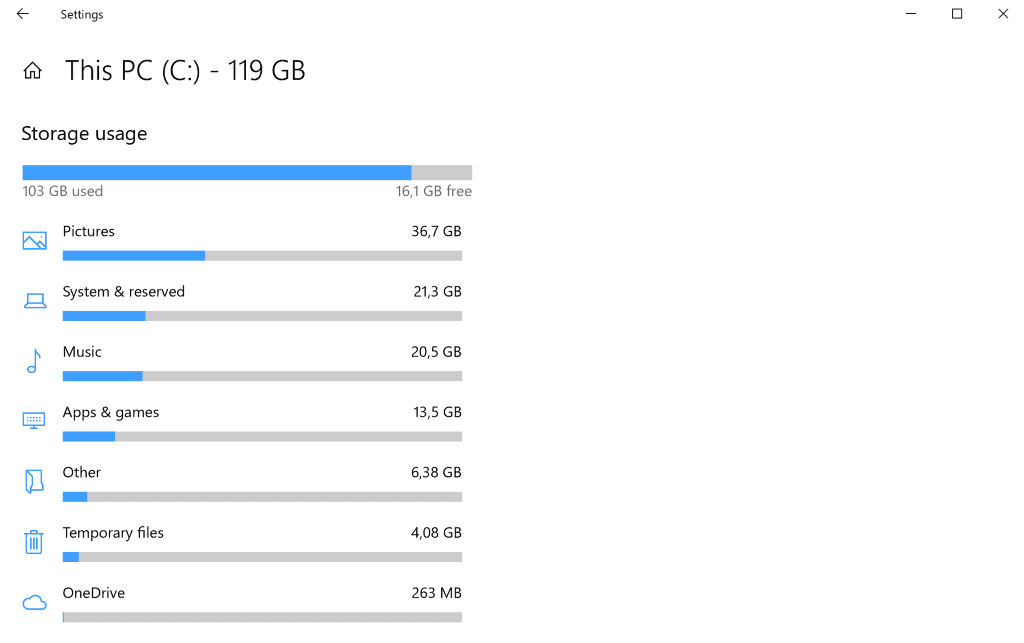Microsoft on freeing up space for Windows 10 Updates
Microsoft published a new support article "Windows 10 update issues on devices with low storage space" yesterday.
Released in time for the next feature update for the operating system, Windows 10 version 1809 also known as the October 2018 Update, it highlights that updates may fail when disk space is low and provides suggestions on how to free up disk space.
Microsoft's resolution to avoid the issue is to run a series of operations to free up disk space on the device.

In particular, Microsoft suggests:
- To delete temporary files in Settings (Windows-I) > System > Storage > This PC > Temporary Files.
- To delete downloaded files in Settings > System > Storage > This PC > Temporary Files > Downloads > View Downloads.
- To empty the Recycle Bin in Settings > System > Storage > This PC > Temporary Files > Recycle Bin > Empty Recycle Bin (tip: you may also reduce the available storage space for the Recycle Bin)
- To uninstall apps that are not used anymore in Settings > System > Apps & Features.
- To move files to a USB Drive or another drive. Select the files in File Explorer, the Home > Move To > Choose location.
- To save new files to another drive.
- To keep only some OneDrive files on the system. To do so, right-click on the OneDrive icon and select Settings > Choose folders and uncheck folders that you don't require on the PC to free up space.
The common sense instructions read almost like an advertisement for using the Settings application more as the first part five of the eight suggestions ask you to use it. It is certainly possible to clean the Recycle Bin using Microsoft's suggested method but it is equally possible to right-click on the icon on the desktop to clean it right from there. The latter may be faster.
Some users may use the Disk Cleanup tool for some of the operations but Microsoft revealed that it is deprecated. While still available, it will be removed eventually.
Storage Sense supports the automatic deletion of temporary files on Windows 10; so that may be an option going forward.
As for moving, I suppose using the menubar is the easiest way but most users will probably either use "cut" from the right-click menu or hold down the Shift-key to move files instead of copying them to another drive.
The cause
More telling is Microsoft's explanation for issues caused by low disk space during upgrades besides the obvious elephant in the room that devices with low amounts of disk space are sold as Microsoft's minimum requirements for Windows 10 devices don't prevent manufacturers from doing so.
Microsoft Surface devices are offered with 64 Gigabytes of storage space which is not a lot either but some manufacturers produce devices with 32 Gigabytes of storage space. A large portion of the space is already occupied by Windows.
The cause according to Microsoft? Microsoft confirms that "Windows Update does not check systems for adequate space requirements before it initializes".
The company does not reveal why Windows does not check for sufficient storage space before updates are initialized. Doing so would certainly help users as Windows could "tell them" to free up a certain amount of disk space before running the installer.
While it is certainly helpful if users clean certain files, temporary files or old downloads, regularly on their devices, it should be the developer's responsibility to implement proper checks during the initialization of updates.
As Woody Leonhard puts it so eloquently: "You'd think that with all the hundreds of millions MS has spent on Windows installers, it would've fixed the ooops-it's-too-small bug a while ago. Right up there with the "SSU before LCU" ridiculousness".
See also: Windows 10 version 1809 removed or deprecated features
Now You: Did you run into Windows update issues recently?
This article was first seen on ComTek's "TekBits" Technology News

- Log in to post comments